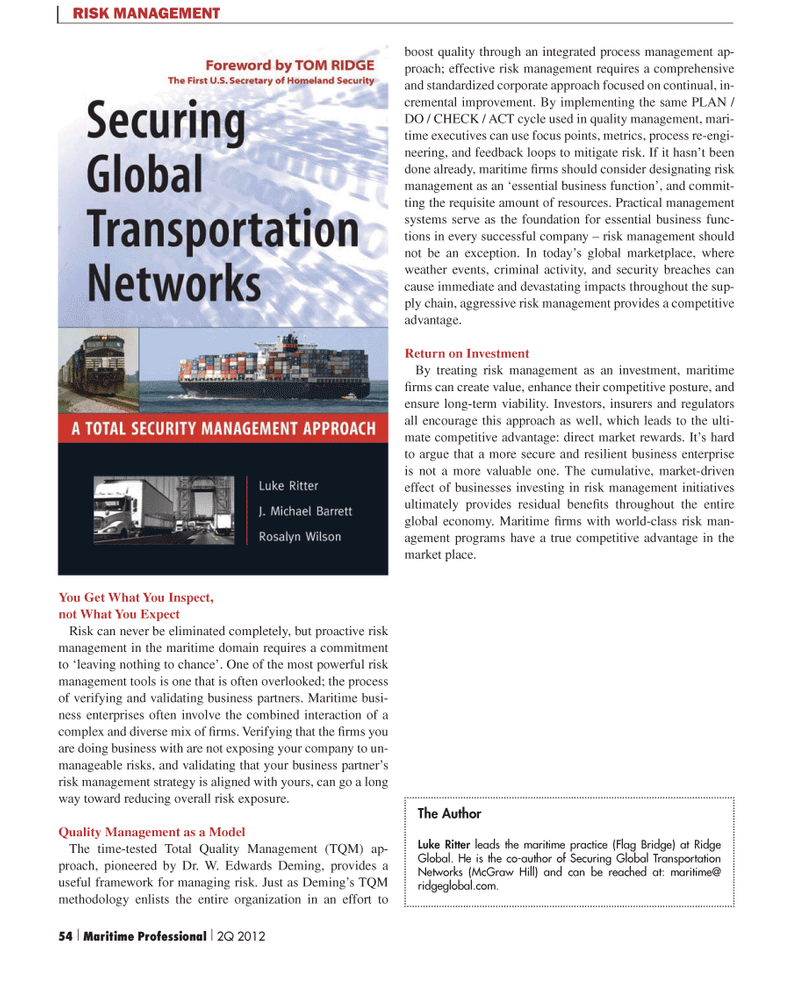
Page 54: of Maritime Logistics Professional Magazine (Q2 2012)
Maritime Risk
Read this page in Pdf, Flash or Html5 edition of Q2 2012 Maritime Logistics Professional Magazine
You Get What You Inspect, not What You Expect
Risk can never be eliminated completely, but proactive risk management in the maritime domain requires a commitment to ‘leaving nothing to chance’. One of the most powerful risk management tools is one that is often overlooked; the process of verifying and validating business partners. Maritime busi- ness enterprises often involve the combined interaction of a complex and diverse mix of fi rms. Verifying that the fi rms you are doing business with are not exposing your company to un- manageable risks, and validating that your business partner’s risk management strategy is aligned with yours, can go a long way toward reducing overall risk exposure.
Quality Management as a Model
The time-tested Total Quality Management (TQM) ap- proach, pioneered by Dr. W. Edwards Deming, provides a useful framework for managing risk. Just as Deming’s TQM methodology enlists the entire organization in an effort to boost quality through an integrated process management ap- proach; effective risk management requires a comprehensive and standardized corporate approach focused on continual, in- cremental improvement. By implementing the same PLAN /
DO / CHECK / ACT cycle used in quality management, mari- time executives can use focus points, metrics, process re-engi- neering, and feedback loops to mitigate risk. If it hasn’t been done already, maritime fi rms should consider designating risk management as an ‘essential business function’, and commit- ting the requisite amount of resources. Practical management systems serve as the foundation for essential business func- tions in every successful company – risk management should not be an exception. In today’s global marketplace, where weather events, criminal activity, and security breaches can cause immediate and devastating impacts throughout the sup- ply chain, aggressive risk management provides a competitive advantage.
Return on Investment
By treating risk management as an investment, maritime fi rms can create value, enhance their competitive posture, and ensure long-term viability. Investors, insurers and regulators all encourage this approach as well, which leads to the ulti- mate competitive advantage: direct market rewards. It’s hard to argue that a more secure and resilient business enterprise is not a more valuable one. The cumulative, market-driven effect of businesses investing in risk management initiatives ultimately provides residual benefi ts throughout the entire global economy. Maritime fi rms with world-class risk man- agement programs have a true competitive advantage in the market place.
The Author
Luke Ritter leads the maritime practice (Flag Bridge) at Ridge
Global. He is the co-author of Securing Global Transportation
Networks (McGraw Hill) and can be reached at: maritime@ ridgeglobal.com.
RISK MANAGEMENT 54 | Maritime Professional | 2Q 2012
MP #2 50-64 NEW STYLES.indd 54 5/8/2012 10:42:09 AM

 53
53

 55
55
